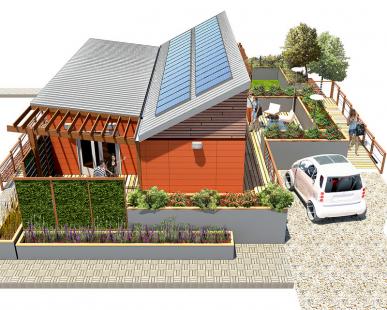This commentary originally appeared on EDF’s Voices blog.
These days, the future is often in the news. It’s not uncommon to come upon articles about cars that drive themselves, vacation trips to space, and automated smart houses a la the Jetsons.
I don’t know much about space tourism or self-driving cars, but I do know that smart homes and the associated technologies are already allowing for the possibility of environmental benefits and economic savings that are nothing short of futuristic.
Our utility grid is the largest machine in world. Unfortunately, however, this machine exacts human and environmental costs all the way down the line — from extraction to combustion. But we’re at the beginning of an energy revolution in home energy management systems that may make consumers key players in solving these problems.
What are home energy management systems (HEMS)?
The platform for increased interaction between consumers and the energy grid will be home energy management systems (HEMS), devices that are part iPad-for-your-home and part thermostat. Some of these devices already exist – from apps that allow users to play games and earn rewards while saving electricity, to GPS-enabled programs that cool down your house when you’re on your way home from work in the summer .
It has been forecast that the number of households with HEMS will grow to more than 40 million in 2020. (Companies like SONY and Hitachi are in the R&D phase with HEMS devices, while Nest and Check-It already have some on the market.) And if HEMS can be combined with services we already use — like utilities, security, cell and Internet, then more consumers will buy in.
Why aren’t more people using home energy management systems?
The problem, so far, is that technological advances in our electrical grid have tended to benefit the utilities more than the consumer. For example, by the end of 2015, approximately “45% of all U.S. households will be served by smart meters. But as few as 10% of those meters will be enabled for two-way communications” via HEMS.
Lacking that interactive connection with the energy grid, consumers won’t fully benefit from HEMS’ capabilities, like providing them with real-time information on energy costs and usage, which will let people save money by using power when its costs are lowest, and even earning money by selling unused, locally generated power (say from rooftop solar panels) back to the utilities.
That’s where the future of energy usage is today. We’ve reached the point where we have the technical ability to create a true interactive smart grid that benefits consumers and utilities and the environment. But we haven’t yet put in place the state-by-state rules and regulation that will allow all that futuristic technology to take full effect. In many cases even repealing burdensome regulations, red tape, and old ways of doing business will be necessary so that markets can thrive and not simply be designed to benefit monopolistic industries.
There are market-based obstacles that can be overcome, and EDF is working in a number of states – from Illinois to California to Texas – to get the regulations rightfor a true smart grid that will bring convenience, savings and environmental benefits to consumers, utilities and the environment.











One Comment
I think it is rather naive to think that providing the HEMS with the needed interactive connectivity alone, will result in an active usage of the HEMS. I found that even though the rules and regulations are in place and consumers are provided with a HEMS, solar panels, smart appliances (washing machine and dryer) and dynamic electricity prices, the effects on demand shift that can be achieved are still severe.
Participating consumers experienced a change in their behaviour, and the HEMS became part of their routine at home. They even reported to shift the usage of their smart appliances to off-peak moments mostly because this saved them money. However the group as a whole did not perform any better than people without these smart appliances in terms of peak demand reduction (thus limited benefits for the utility company).
This raises the question, how many electricity can be used on ? according to studies, in the future, up to 10% of the demand will be shiftable (including electric vehicles) (source: Veldman et al, 2013). For an European family this is about 1kWh of shiftable electricity per day.
What consumers are waiting on now is the ability of more electrical appliances to be shifted. This is where consumers gain benefit of the HEMS. nowadays there are only limited appliances on the market which can communicate with the HEMS, and the appliances that do, will require some time to return the investement.
Off course all the mechanisms and regulation needs to be in place to support those products, but that is not in direct seight of the mass consumers. If we want to make an impact, we need to accalerate the market of smart appliances, altough one must remember the consumers’ benefits achieved with HEMS usage could be dissapointing.